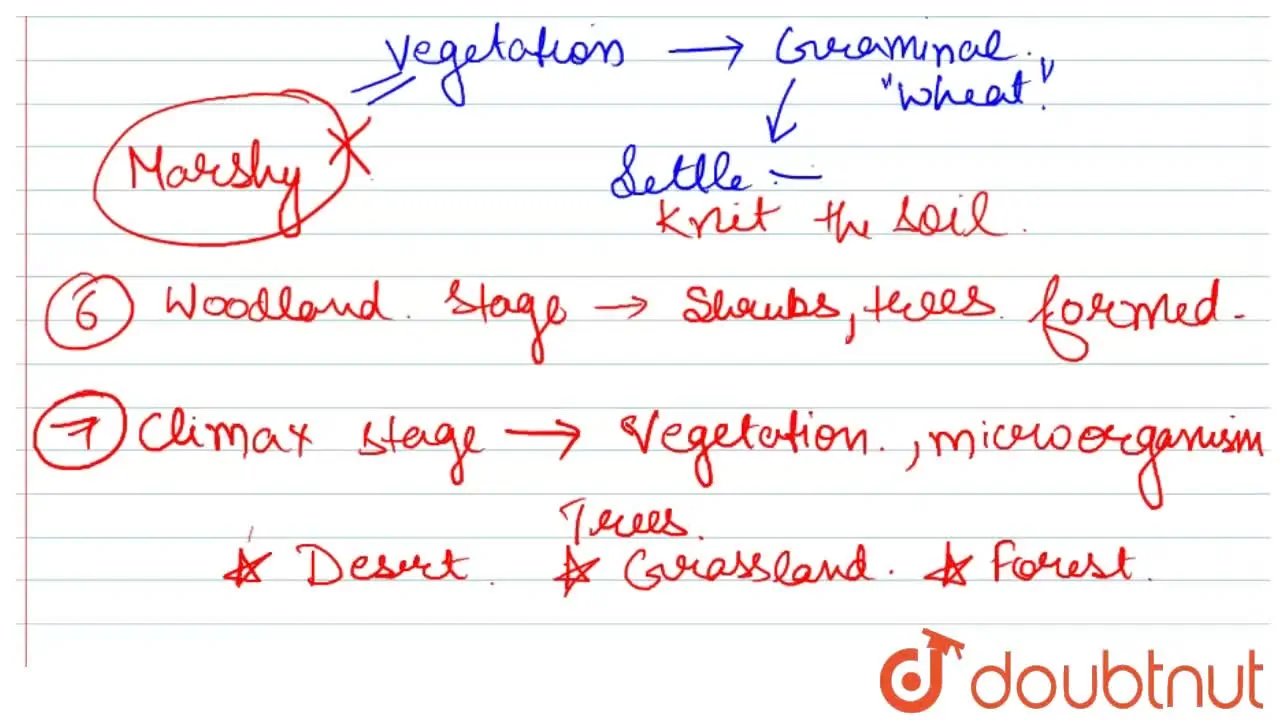Discuss various stages occurring in a hydrosere formation.Solution in Punjabi
Biotic Succession In Newly Form. Pondflake (Hydrosere). Serve of biotic communities that develop in a newly formed pond or lake is called hydrosere. It starts as soon as the muddy water becomes clear. The various successional or send stages of hydrosere are :—
1. Plankton Stage. It is the pioneer stage of hydrosere. Spores of this stage reach the water body through wind or animals. The first to appear are minute autotrophic organisms called phyloplankton, e.g., diatoms, green flagellates, single- celled colonial or filamentous green algae as well as blue-green algae. They multiply rapidly. Soon a balance is created by the appearance of zooplankton which feed on phytoplankton. Death and decomposition of plankton produce organic matter. The latter mixes up with clay and silt at the bottom tb form soft mud favourable for growth of next sera stage.
2. Submerged Stage. The bottom lined by soft mud having organic matter is favourable for growth of submerged plan. like Hydrilla Potamogeton and Najas .limy are rooted in the mud and form dense growth. As a result sand and silt get deposited around the plants. The bottom level, therefore, rises slowly. The older plants and buried parts of other plants form humus on their death .d decay. llns enriches the newly built up bottom and makes it favourable for growth of next stage.
3. Floating Stage. Floating leaved anchored plan. (e.g., Nymphae. Nelumbo, Nuphar)appear where water becomes shallow. These plants have subterranean stems like rhizome and tub. The plants make the water rich in mineral and organic natter. It becomes suitable for growth of tree floating plan. like Lemna, Spirodela, Wholfiila Azolla, Eichhoria , etc. They cover the water quickly. Rapid growth of floating stage further builds up bottom so that water becomes shallow .
4. Reed Swamp Stage. Amphibious plants grow where the water body becomes shallow (0:3-1.0 m), e.g.. Phragmites ,Typha,scirpus,sagittaria The plants of Reed swamp stage transpire and produce abundant organic matter and their growth accumulates silt.
5 Sedge or Marsh Meadow Sage. The shores built by above stage arc invaded by Carex (Sedge). fences, Cyperus, Cgrasses . Dlchantium and herbs like Polygonum, companule etc. he plants transpire and add enormous humus. So soil is built up and create condition for invasion of next stage.
6. Woodland Stage. The periphery of sedge meadow stage is invaded by some rhizome bearing shrubby plants which can tolerate bright sunlight as well as water logged conditions, e.g.. cornus, (Bogwood), Cephalanthus (Button Brush). The shrubs shade away the plants of sedge meadow stage. They invite invasion by trees capable of bearing bright sunlight and waterlogging, e.g., Popular (Cottonwood), Alms (Alder). The plants of woodland stage lower the water table by their transpiration. They also built up more soil. Shade loving plants come to grow below them.
7. Climax Forest. New trees invade the area They have shade loving seedlings. These trees grow to greater heights.l. trees and shrubs of woodland stage disappear. The climax forest depends upon the climate— rain forest in moist tropical area and mixed coniferous or deciduous forest in temperate area. A mixed temperate forest includes broad leaved trees like Quercus (Oak), Ulmus (Elm) and Aces and gymnosperms like Able: (Fir), Taxus (Yew) and Picea (Spruce).
Related Playlists
- BOOK - BETTER CHOICE PUBLICATIONCHAPTER - ECOSYSTEMEXERCISE - MOST EXPECTED QUESTIONS30videos
ECOSYSTEM
- BOOK - BETTER CHOICE PUBLICATIONCHAPTER - ECOSYSTEMEXERCISE - SHORT ANSWER TYPE QUESTIONS II24videos
ECOSYSTEM
- BOOK - BETTER CHOICE PUBLICATIONCHAPTER - BIOTECHNOLOGY AND ITS APPLICATIONSEXERCISE - LONG ANSWER TYPE QUESTIONS18videos
BIOTECHNOLOGY AND ITS APPLICATIONS
- BOOK - BETTER CHOICE PUBLICATIONCHAPTER - ENVIRONMENTAL ISSUES EXERCISE - LONG ANSWER43videos
ENVIRONMENTAL ISSUES
Similar Questions
What is detritus?
02:22View SolutionDefine ecological succession. Give four differences between seral stage and climax stage.
03:30View SolutionExplain the role of biotechnology in therapeutics.
03:03View SolutionDiscuss the causes of global warming. What measures need to be taken to control global warming?
01:27View SolutionThe second stage of hydrosere is occupied by plants like
01:45View SolutionThe correct sequence of seral stages in hydrosere is:
01:59View SolutionThe second stage of hydrosere is occupied by plants like
06:27View SolutionIn the hydrosere the reed - swamp stage is followed by
05:28View SolutionHydrosere start with which stage
02:31View SolutionSere stage in hydrosere stage
04:07View SolutionDescribe about the different stages of hydrosere.
06:36View SolutionIn hydrosere, the stages that come before and after the reed-swamp stage are, respectively,
06:36View SolutionDiscuss the stages at which substrate phosphorylation occurs in glycolysis.
01:06View SolutionThe second stage of hydrosere is occupied by plants like
03:17View SolutionDiscuss various stages occurring in a hydrosere formation.
03:30View SolutionDefine Hydrosere.Explain various stages in hydrosere.
02:10View Solution


